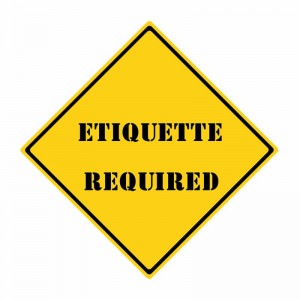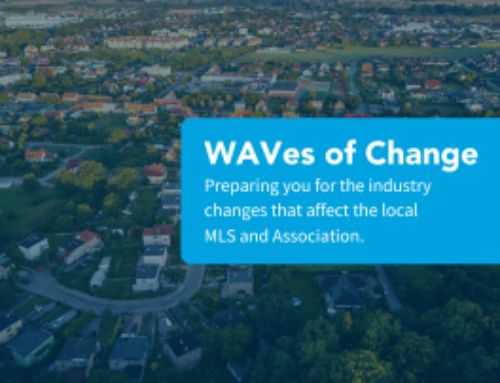 It could be just me. I may have attended too many trade shows.
It could be just me. I may have attended too many trade shows.
Yet somehow I believe Emily Post would have been appalled if she walked the exhibits at NAR Midyear.
To add a little context, I have attended, exhibited, sponsored and run trade shows.
In fact, I’m afraid to count the number of miles I have walked on trade show floors, having attended many NAR-FAR-CAR annuals, NAR Midyears, HomeBuilders/IBS, PCBCs, COMDEX, CES, IBC and others.
I have also been the lead for many firms exhibiting at these same shows, and have found myself staffing exhibits, including too many hours at a booth that was in the bowels of a covered bus garage at the Sheraton in Hawaii (NAR 1987).
I helped Brad Inman produce more than a half-dozen of the first Real Estate Connects, so I have done more than worked the floor or staffed a booth: I sold all the space and sponsorships.
So I am probably being a hard ass about all this when I ask: What ever happened to Trade Show etiquette?
Rules to follow
Less than a minute after I walked inside the hall on Thursday at 2 pm at NAR Midyear, I was taken aback.
I looked around the room and I saw body language at almost every exhibit that said “Stay away, I’m busy.”
People were eating and drinking (water, sodas) at their booths.
Rule #1: Never eat or drink at a booth, do it somewhere else. Yes, if budget constraints leave you as the sole staffer, you need to drink water and stay hydrated. But do it discretely. I’m not going to come talk to you if you are leaning up against a counter in the back of your booth with a water bottle in your hand. If you are eating at your booth, well, think about the message that sends: We can’t afford to have anyone else here, so I have to eat at my booth. I don’t think that’s a message that you want tied to your brand.
People were sitting in chairs, behind and next to counters.
Rule #2: Stand, don’t sit. This is where most people make the biggest mistake. The best way to engage people is when you are standing. If you are sitting, you send the message you really don’t care or are too tired to stand. Either way, that doesn’t invite me to talk to you. It feels more like I am interrupting you at your desk when you sit. So I walk by. And I turned around and watched everyone else walk by to. Oh, and no one sitting even greeted me with their eyes, much less actually said something like, “Hello, How are you today? Meetings going well for you?”
Almost everyone I saw was looking down: Heads were bent and they were reading, texting or playing with their nails. One was surfing the web on their big display. I could count the number of exhibitors who were smiling on one hand. Ouch.
Rule #3: Eyes forward, smile, please don’t text or surf. You have to let people know you want to talk to them. You can great someone with your eyes and a smile and get them to stop and talk to you without ever saying a word. Somehow we forgot this simple principal: If you look like you want to be some place else, you probably should and not be staffing a trade show booth.
I walked by two very nice booths; both pretty big, both with at least one giant flat screen that displayed an “Error Code” and a frozen program on the screen. People staffing these booths were oblivious to their displays being on the fritz. I circled back to these booths and 20 minutes later, both screens were unchanged.
Rule #4: Constantly check your booth, and double-check any technology. Here’s the big point: Your exhibit is your brand – it tells people instantly who you are as a firm and what you are about. If the booth is disorganized and sloppy, think of the message that sends. If you are a tech firm and your screens are frozen what does that say about what it is you do? If you are exhibiting at a Trade Show, you have to put your best foot forward because you are communicating your brand, often instantly, to thousands of people. You can make that a positive message or a negative one. Unfortunately people tend to remember negative experiences longer – and tell other people about it.
I saw some great conversations happening. Unfortunately it was between co-workers at their booths. They were unaware of my slow walk by, even though the look on my face was trying to convey that I was interested. However, they were too interested in each other. It could have been worse, and it was: One well-known software vendor left their booth completely unstaffed. No “back in 5 minutes” note, just no one there. Double ouch.
Rule #5: Talk to others, not among yourselves and always have someone at the booth. Sure, there will be down times and chit-chat makes the clock feel faster, but the minute someone is in eye-range, shut it down and move to the perimeter of your booth and be ready to make someone feel welcome. It’s easy to break the ice and start a conversation at a trade show. But you won’t get that opportunity if you are not focused on the reason you are there.
And there’s the rub: Why are these companies exhibiting in the first place?
It is clear to me that many companies are not focused on answering this question seriously enough. It feels like the appearance at Midyear is obligatory (our competitors are here, so we need to be), or done to show their brand and keep top-of-mind awareness. If the later is the case, most firms I witnessed were doing more harm than good.
These shows were once a place to sell things. That doesn’t appear to be the case at all anymore, it feels more like a game of “Whack a Mole,” as a client described it to me on the phone the other day: All I really am is a new prospect to put into their CRM and begin dripping on me.
Well that’s not going to work very well if these firms don’t follow the basic rules of etiquette at a Trade Show. I mean if they don’t do it right there, how do I know they will get it right elsewhere?
# # #





Well said, Kevin!
Well said !
It is all bout being engaging and/or engagable !
Stand UP and Stand OUT !
Smile !
OFFER your Take~A~Way !
Don’t make someone feel they have to ask for it –
I remember when I got my first set of Business Cards –
I was so proud – I coveted them `
My lovely Broker called me a “Secret Agent” cuz I was NOT giving out a card every time I
shook a hand.
We purchase these things as a reminder to the recipient to spread our Name and contact info.
They are called “Give~A~Ways – Not “You get one if you ask.”
So did you actually buy anything? Maybe vendors are tired of tire kickers strolling by picking up free shwag ?
Great question: No I didn’t buy anything, but I also wasn’t offered anything to buy. I terms of “shwag,” there was very little tchotchkes available. I actually didn’t even pick up a pen. One thing to think about at a trade show: You may have someone kicking the tires, but chances are someday they are going to buy.
Your criticism of the real estate trade show environment is spot-on. For years, vendors effectively paid for many conference expenses for the “opportunity” to exhibit. It’s common knowledge that few actual sales are made “on the floor.” So now we have this paradox where nobody wants to either buy or sell anything on a conference floor. Vendors just want your contact info (from the whack-a-mole game) so you can be barraged with emails that you’ll never open. Often, vendors will subcontract local “talent” to man the whack-mole-booth; so nobody of any value within the organization has to endure the long hours required to “man the booth.” You end up with a lot of millennial part-timers who actually know very little about the company that they are purporting to represent. And mellennials get bored easily (could you tell?). The smart (mainly enterprise) vendors are in the hotel lobby scheduling meetings; and all they paid-for was airfare and hotel. The tradeshow concept for real estate is dead and it’s been dead for years. There are better ways to spend one’s time.
Well said. Vendors probably heard we do not like “pushy” so they have gone extreme in the opposite direction and are oblivious to their purpose and our interest. Hopefully, this article will open some eyes. 🙂
You nailed it Marilyn. I too have witnessed this disconnect; body language that says “I am too preoccupied to talk to you”. Surprisingly it is not always lower level staff who are working some of these booths that are unwelcoming. I have to believe there is likely a connection between these clueless vendors and the level of customer satisfaction these companies have among their existing clients and customers. Typically organizations that “get it” when it comes to providing exemplarily customer service have a philosophy of service that permeates throughout the organization, and that would include those staff stuck working the booth.
you took the words out of my mouth. And, if you mention any of these issues as constructuive criticism, exhibitors are insulted and never get the message. furthermore, exhibitors send the least informed person on the trip so we cannot learn/buy any product because no one can explain it.
As an exhibitor at many trade shows, I am constantly irritated by other vendors that are too cheap to buy booth space, that are trying to sell me and my team on their products when we are in our exhibits trying to engage with our own customers. Bad form.
long live the scarf king !!
Some things NEVER change … that and the jewelry booth…
Sometimes the truth hurts…but the same bad behavior is rampant at trade shows in all industries, and I’ve worked at many over the past couple decades. As a trade show manager, I gave my sales teams pre-show training to make sure they knew; how NOT to behave (all the examples listed by Kevin), what was the key message they needed to deploy, their qualified lead goal for each booth staffer, what was a qualified lead (and it is not just a scanned badge or a business card to add to the database!), and how much a qualified lead costs. When they realize how much the company is investing to be at the show, it puts a value on “my efforts will either make us money, or my lack of effort will surely waste the thousands of dollars spent to put me in this booth”! A successful trade show is not just a display and a couple bodies standing in front of it. It takes planning, and most importantly staffers who want to engage attendees. Remember, show attendees want to be there, they want to meet you, and find out how you can help them. Don’t miss these opportunities.
I noticed the same thing at NAR in NOLA. I’m also a veteran of trade shows from both sides of the effort having designed and sold exhibits to actually producing several events. I constantly consulted on NEVER putting a table or anything in the front of the booth that separated a presenter from a prospect, however, there were several instances where clients did exactly the opposite of what we recommended after the start of the show. Eating in the booth is my number one pet peeve. Heads down reading text messages and playing games. No eye contact.
Im amazed at the investments in what I call CPS (cheap promotional “stuff”) Call it SWAG or whatever, it’s almost always a waste of marketing $$. I once designed an interactive presentation for a client that was put on a 3.5 floppy disk (yeah, I’m old) Most people throw away every brochure, in order to insure the disk didn’t meet the same fate, we incentivized people to view it by making 3 of the disks winners of a 19″ monitor. The only way to know if you won, was to view the entire presentation. The conversion rate was off the charts and marketing spend was less than buying and shipping huge boxes of CPS that were destined to be given to someone’s kid or end up in the circular file.
Years later I was able to gather all of my trade show knowledge and shoestring exhibiting at a NAR conference in Orlando. On a small budget we were still able to knock down our first big sale (over $500K) from a 10 foot booth two rows over from the jewelry and free vacation booths. Trade shows are increasingly expensive to participate in and without a great strategy and accountability for the effort, it’s just another marketing machination tantamount to lighting a match to a huge pile of cash.
Well said! Its was disappointing in the very least to see so many booths “unattended” by staffers off talking to their neighbors or looking at their smart phones – no we will NOT be stopping by if everyone is sending the message that they are too busy to talk to us….I even saw it happening at some of the largest exhibitors’ booths. They had plenty of staff in them – just completed unengaged staff, too bad.